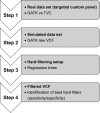Next-generation sequencing: advances and applications in cancer diagnosis
- PMID: 27980425
- PMCID: PMC5144906
- DOI: 10.2147/OTT.S99807
Next-generation sequencing: advances and applications in cancer diagnosis
Abstract
Technological advances have led to the introduction of next-generation sequencing (NGS) platforms in cancer investigation. NGS allows massive parallel sequencing that affords maximal tumor genomic assessment. NGS approaches are different, and concern DNA and RNA analysis. DNA sequencing includes whole-genome, whole-exome, and targeted sequencing, which focuses on a selection of genes of interest for a specific disease. RNA sequencing facilitates the detection of alternative gene-spliced transcripts, posttranscriptional modifications, gene fusion, mutations/single-nucleotide polymorphisms, small and long noncoding RNAs, and changes in gene expression. Most applications are in the cancer research field, but lately NGS technology has been revolutionizing cancer molecular diagnostics, due to the many advantages it offers compared to traditional methods. There is greater knowledge on solid cancer diagnostics, and recent interest has been shown also in the field of hematologic cancer. In this review, we report the latest data on NGS diagnostic/predictive clinical applications in solid and hematologic cancers. Moreover, since the amount of NGS data produced is very large and their interpretation is very complex, we briefly discuss two bioinformatic aspects, variant-calling accuracy and copy-number variation detection, which are gaining a lot of importance in cancer-diagnostic assessment.
Keywords: colorectal cancer; hematologic cancer; hereditary breast cancer; lung cancer; melanoma; prostate cancer; thyroid cancer.
Conflict of interest statement
The authors report no conflicts of interest in this work.
Figures



Similar articles
-
[Lung cancer molecular testing, what role for Next Generation Sequencing and circulating tumor DNA].Ann Pathol. 2016 Jan;36(1):80-93. doi: 10.1016/j.annpat.2015.11.012. Epub 2016 Jan 20. Ann Pathol. 2016. PMID: 26803564 French.
-
Next-Generation Whole-Exome Pattern: Advanced Methods and Clinical Significance.Curr Gene Ther. 2025 Apr 14. doi: 10.2174/0115665232356780250331181436. Online ahead of print. Curr Gene Ther. 2025. PMID: 40231504
-
Comprehensive next-generation cancer genome sequencing in the era of targeted therapy and personalized oncology.Biomark Med. 2011 Jun;5(3):293-305. doi: 10.2217/bmm.11.37. Biomark Med. 2011. PMID: 21657839 Review.
-
Whole genome sequencing for lung cancer.J Thorac Dis. 2012 Apr 1;4(2):155-63. doi: 10.3978/j.issn.2072-1439.2012.02.01. J Thorac Dis. 2012. PMID: 22833821 Free PMC article.
-
Next-Generation Sequencing in Oncology: Genetic Diagnosis, Risk Prediction and Cancer Classification.Int J Mol Sci. 2017 Jan 31;18(2):308. doi: 10.3390/ijms18020308. Int J Mol Sci. 2017. PMID: 28146134 Free PMC article. Review.
Cited by
-
DNA Methylation and Epigenetic Events Underlying Renal Cell Carcinomas.Cureus. 2022 Oct 27;14(10):e30743. doi: 10.7759/cureus.30743. eCollection 2022 Oct. Cureus. 2022. PMID: 36447689 Free PMC article. Review.
-
Droplet digital polymerase chain reaction assay and peptide nucleic acid-locked nucleic acid clamp method for RHOA mutation detection in angioimmunoblastic T-cell lymphoma.Cancer Sci. 2018 May;109(5):1682-1689. doi: 10.1111/cas.13557. Epub 2018 Mar 31. Cancer Sci. 2018. PMID: 29493850 Free PMC article.
-
Next-Generation Sequencing in Cancer.J Maxillofac Oral Surg. 2021 Sep;20(3):340-344. doi: 10.1007/s12663-020-01462-4. Epub 2020 Oct 16. J Maxillofac Oral Surg. 2021. PMID: 34408360 Free PMC article. Review.
-
Visualizing gene expression changes in time, space, and single cells with expressyouRcell.iScience. 2023 May 11;26(6):106853. doi: 10.1016/j.isci.2023.106853. eCollection 2023 Jun 16. iScience. 2023. PMID: 37250782 Free PMC article.
-
Towards population-based genetic screenings for breast and ovarian cancer: A comprehensive review from economic evaluations to patient perspectives.Breast. 2021 Aug;58:121-129. doi: 10.1016/j.breast.2021.04.011. Epub 2021 May 12. Breast. 2021. PMID: 34022715 Free PMC article. Review.
References
-
- Li W, Zhao K, Kirberger M, Liao W, Yan Y. Next generation sequencing technologies in cancer diagnostics and therapeutics: a mini review. Cell Mol Biol (Noisy-le-grand) 2015;61(5):91–102. - PubMed
-
- D’Argenio V, Esposito MV, Telese A, et al. The molecular analysis of BRCA1 and BRCA2: next-generation sequencing supersedes conventional approaches. Clin Chim Acta. 2015;446:221–225. - PubMed
Publication types
LinkOut - more resources
Full Text Sources
Other Literature Sources

